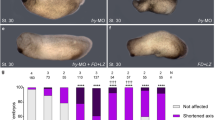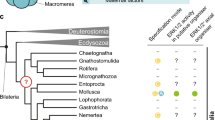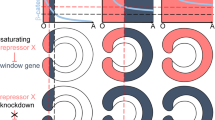Abstract
Twisted gastrulation (TSG) is involved in specifying the dorsal-most cell fate in Drosophila embryos1, but its mechanism of action is poorly understood. TSG has been proposed to modify the action of Short gastrulation (SOG), thereby increasing signalling by the bone morphogenetic protein (BMP) Decapentaplegic. SOG, an inhibitor of BMP signalling, is in turn inactivated by the protease Tolloid2,3. Here we identify Tsg gene products from human, mouse, Xenopus, zebrafish and chick. Expression patterns in mouse and Xenopus embryos are consistent with in vivo interactions between Tsg, BMPs and the vertebrate SOG orthologue, chordin. We show that Tsg binds both the vertebrate Decapentaplegic orthologue BMP4 and chordin, and that these interactions have multiple effects. Tsg increases chordin's binding of BMP4, potentiates chordin's ability to induce secondary axes in Xenopus embryos, and enhances chordin cleavage by vertebrate tolloid-related proteases at a site poorly used in Tsg's absence; also, the presence of Tsg enhances the secondary axis-inducing activity of two products of chordin cleavage. We conclude that Tsg acts as a cofactor in chordin's antagonism of BMP signalling.
This is a preview of subscription content, access via your institution
Access options
Subscribe to this journal
Receive 51 print issues and online access
$199.00 per year
only $3.90 per issue
Buy this article
- Purchase on Springer Link
- Instant access to full article PDF
Prices may be subject to local taxes which are calculated during checkout



Similar content being viewed by others
Change history
01 June 2001
An Erratum to this paper has been published: https://doi.org/10.1038/35079659
References
Mason, E. D., Konrad, K. D., Webb, C. D. & Marsh, J. L. Dorsal midline fate in Drosophila embryos requires twisted gastrulation, a gene encoding a secreted protein related to human connective tissue growth factor. Genes Dev. 8, 1489– 1501 (1994).
Francois, V., Solloway, M., O'Neill, J. W., Emery, J. & Bier, E. Dorsal-ventral patterning of the Drosophila embryo depends on a putative negative growth factor encoded by the short gastrulation gene. Genes Dev. 8, 2602– 2616 (1994).
Marqués, G. et al. Production of a DPP activity gradient in the early Drosophila embryo through the opposing actions of the SOG and TLD proteins. Cell 91, 417– 426 (1997).
Oelgeschlager, M., Larrain, J., Geissert, D. & De Robertis, E. M. The evolutionarily conserved BMP-binding protein Twisted gastrulation promotes BMP signalling. Nature 405, 757– 763 (2000).
Yu, K. et al. Processing of the Drosophila Sog protein creates a novel BMP inhibitory activity. Development 127, 2143– 2154 (2000).
Scott, I. C. et al. Mammalian BMP-1/ Tolloid-related metalloproteinases, including novel family member mammalian tolloid-like 2, have differential enzymatic activities and distributions of expression relevant to patterning and skeletogenesis. Dev. Biol. 213, 283– 300 (1999).
Chang, C. et al. Twisted gastrulation can function as a BMP antagonist. Nature 410, 483– 487 (2001).
Sasai, Y. et al. Xenopus chordin: A novel dorsalizing factor activated by organizer-specific homeobox genes. Cell 79, 779– 790 (1994).
Piccolo, S., Sasai, Y., Lu, B. & De Robertis, E. M. Dorsoventral patterning in Xenopus: Inhibition of ventral signals by direct binding of Chordin to BMP-4. Cell 86, 589– 598 (1996).
Blitz, I. L., Shimmi, O., Wünnenberg-Stapleton, K., O'Connor, M. B. & Cho, K. W. Y. Is Chordin a long-range or short-range acting factor? Roles for BMP1-related metalloproteases in regulating chordin action. Dev. Biol. 223, 120– 138 (2000).
Larraín, J. et al. BMP-binding modules in chordin: a model for signalling regulation in the extracellular space. Development 127, 821– 830 (2000).
Arora, K., Levine, M. S. & O'Connor, M. B. The screw gene encodes a ubiquitously expressed member of the TGF-β family required for specification of dorsal cell fates in the Drosophila embryo. Genes Dev. 8, 2588– 2601 (1994).
Ferguson, E. L. & Anderson, K. V. Localized enhancement and repression of the activity of the TGF-β family member, decapentaplegic, is necessary for dorsal-ventral pattern formation in the Drosophila embryo. Development 114, 583– 597 (1992).
Arora, K. & Nüsslein-Volhard, C. Altered mitotic domains reveal fate map changes in Drosophila embryos mutant for zygotic dorsoventral patterning genes. Development 114, 1003– 1024 (1992).
Wharton, K. A., Ray, R. P. & Gelbart, W. M. An activity gradient of decapentaplegic is necessary for the specification of dorsal pattern elements in the Drosophila embryo. Development 117, 807– 822 (1993).
Holley, S. A. et al. The Xenopus dorsalizing factor noggin ventralizes Drosophila embryos by preventing DPP from activating its receptor. Cell 86, 607– 617 (1996).
Holley, S. A. et al. A conserved system for dorsal–ventral patterning in insects and vertebrates involving sog and chordin. Nature 376, 249– 253 (1995).
Zusman, S. B., Sweeton, D. & Wieschaus, E. F. Short gastrulation, a mutation causing delays in stage specific cell shape changes during gastrulation in Drosophila melanogaster. Dev. Biol. 129, 417– 427 (1988).
Ross, J. J. et al. Twisted gastrulation is a conserved extracellular BMP antagonist. Nature 410, 479– 483 (2001).
Kohfeldt, E., Maurer, P., Vannahme, C. & Timpl, R. Properties of the extracellular calcium binding module of the proteoglycan testican. FEBS Lett. 414, 557– 561 (1997).
Zhu, Y., Oganesian, A., Keene, D. R. & Sandell, L. J. Type IIA procollagen containing the cysteine-rich amino propeptide is deposited in the extracellular matrix of prechondrogenic tissue and binds to TGF-beta 1 and BMP-2. J. Cell Biol. 144, 1069– 1080 (1999).
Pappano, W. N. et al. Coding sequence and expression patterns of mouse Chordin and mapping of the cognate mouse Chrd and human CHRD genes. Genomics 52, 236– 239 (1998).
Lee, S., Solow-Cordero, D. E., Kessler, E., Takahara, K. & Greenspan, D. S. Transforming growth factor-β regulation of bone morphogenetic protein-1/procollagen C-proteinase and related proteins in fibrogenic cells and keratinocytes. J. Biol. Chem. 272, 19059– 19066 (1997).
Cho, K. W., Blumberg, B., Steinbeisser, H. & De Robertis, E. M. Molecular nature of Spemann's organizer: the role of the Xenopus homeobox gene goosecoid. Cell 67, 111– 1120 (1991).
Harland, R. M. in Methods in Cell Biology (eds Kay, B. K. & Peng, H. B.) 685– 695 (Academic, San Diego, 1991).
Takahara, K., Lyons, G. E. & Greenspan, D. S. Bone morphogenetic protein-1 and a mammalian tolloid homologue (mTld) are encoded by alternatively spliced transcripts which are differentially expressed in some tissues. J. Biol. Chem. 269, 32572– 32578 (1994).
Furuta, Y., Piston, D. W. & Hogan, B. L. M. Bone morphogenetic proteins (BMPs) as regulators of dorsal forebrain development. Development 124, 2203– 2212 (1997).
Acknowledgements
We thank M. O'Connor for the mouse Tsg cDNA clone, J. Fallon for the chick embryo cDNA library, and B. Hogan for BMP2, -4, and -7 cDNA clones. We also thank E. De Robertis and C. Niehrs for Xenopus chordin and Vent2 cDNAs, respectively; S. Kinoshita for technical assistance; T. Koide for technical advice on embryo bleaching; and M. O'Connor, L. Marsh and A. Hemmati-Brivanlou for communicating their work before publication. This work was supported by the NIAMS (D.S.G), NIGMS (D.S.G. and K.W.Y.C.) and NICHD (K.W.Y.C.) of the National Institutes of Health, and by FibroGen (D.S.G.).
Author information
Authors and Affiliations
Corresponding author
Supplementary information
Rights and permissions
About this article
Cite this article
Scott, I., Blitz, I., Pappano, W. et al. Homologues of Twisted gastrulation are extracellular cofactors in antagonism of BMP signalling. Nature 410, 475–478 (2001). https://doi.org/10.1038/35068572
Received:
Accepted:
Issue Date:
DOI: https://doi.org/10.1038/35068572
This article is cited by
-
Highly conserved and extremely evolvable: BMP signalling in secondary axis patterning of Cnidaria and Bilateria
Development Genes and Evolution (2024)
-
Diversity between mammalian tolloid proteinases: Oligomerisation and non-catalytic domains influence activity and specificity
Scientific Reports (2016)
-
EvoD/Vo: the origins of BMP signalling in the neuroectoderm
Nature Reviews Genetics (2008)
-
TGFβ signaling in Tribolium: vertebrate-like components in a beetle
Development Genes and Evolution (2008)
-
Axial patterning in cephalochordates and the evolution of the organizer
Nature (2007)
Comments
By submitting a comment you agree to abide by our Terms and Community Guidelines. If you find something abusive or that does not comply with our terms or guidelines please flag it as inappropriate.



